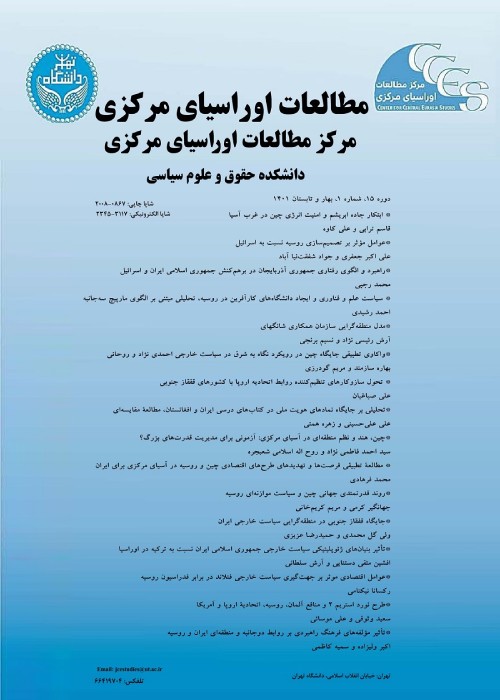Intra-Institutional Dynamics and Its Impact on US-Russian Track-Two Diplomacy
US relations with the Soviet Union during the Cold War and with the Russian Federation thereafter have fluctuated from open hostility to competition. However, during and after the Cold War, Track-Two diplomacy, as an organized and institutionalized mechanism, have complemented the official diplomacy between the two countries. During the cold war, the high level of mistrust and hostility between the two superpowers, which sometimes led to the blockage of official relations, forced both sides to use Track-Two diplomacy. But despite ending of systemic competition and changing in the U.S. - Russian relations during the post-collapse era, Track-Two diplomacy continued with the characteristics of the previous era.
Research Question:
Considering what has been said, the question is how did intra-organizational dynamics lead to the pursuit of Track-Two diplomacy in realizing US and Russian interests during and after the Cold War?
Research Hypothesis:
The hypothesis of the research is that according to the historical path taken during the Cold War, the need to provide the strategic and sustainable interests of each country, the use of institutions with close ties with the government and interactions formed among the participants in informal processes, have caused the continuation of Track-Two diplomacy in U.S. - Russian relations in post-collapse era.
Methodology and Theoretical Framework:
To test the above hypothesis, the theory of “historical institutionalism” has been used. The emphasis of this paper is on the "equation" which is one of the main elements of the theory of historical institutionalism. In this direction and examining the same factors that had the same result in two different periods, the historical-comparative method is based on the comparison of the two periods of the Cold War and after the Cold War. The method of collecting information in this research is qualitative and based on documentary method.
Studying the process of Track-Two diplomacy between the United States and the Soviet Union and its future developments in the post collapse period indicates the necessity of using informal relations to realize foreign policy goals and strategic interests that could not be pursued through official channels. Due to a wall of mistrust between the two countries, Washington and Moscow have faced numerous challenges to reach any kind of agreement. The existence of a growing gap and mistrust at official levels has made it necessary to use government institutions or institutions trusted by governments to implement controlled informal diplomacy in such a way that even the use of Track-Two diplomacy, the experienced people of the two countries resumed the processes with institutionalization in the post-Soviet era.All considered cases were examined in the field of equation, pursuit of benefits resulting from sustainable requirements, dimensions of coalition building interactions and the level of communication between the institutions involved with the center of power. During the Cold War era, there were several strategic interests: improving domestic capabilities, ensuring global strategic stability, and the need for direct communication with the opposing country's society. The adopted strategy was to use institutions or formal institutions with close ties to the government, which led to coalition-building interactions. In the post-collapse period, coalition-building interactions continued but the strategic interests were reduced to geopolitical - regional levels and maintaining the relative level of relations. These goals are generally pursued by non-governmental organizations. Among the three common causal factors in the equation of the two periods of the time, during the Cold War, the ability of Track-Two diplomacy to realize strategic interests is the most important factor.While in the post-collapse era, coalition building interaction is an influential factor.The comparison of the two research periods shows many similarities and differences. The similarities are: the use of the institutional model in Track-Two diplomacy processes, having a high level of support from the governments and the existence of coalition-building interactions in the realization of strategic interests. The most important similarity is the realization of strategic interests which is supported by the highest levels of governance in both periods. This support has been extended to different levels of governance in the post-collapse era. The development of this support is the result of coalition-building interactions formed in the processes of Track-Two diplomacy. The existence of interactions and high-level support in both periods indicates the correspondence of the Track-Two diplomacy in the post Cold War era with its historical path in the Cold War period.Differences can be seen in several fields. As mentioned above, strategic interests are reduced both quantitatively and qualitatively. Participating institutions are increased quantitatively and changed procedurally and substantively. They are changed from 9 governmental institutions to 21 non-governmental institutions. Criticism and opposition to the processes are reduced from the military and security level during the Cold War to the expert level during the post-collapse era. The achievements of Track-Two diplomacy are also decreased in terms of effectiveness. During the Cold War, Track-Two diplomacy processes influenced strategic plans. But in the post-collapse era, they are just a tool for adjusting and re-adjusting relationships.
The findings show that the continuity of the institutional model is common in both periods but the change in the level of interests and the entry of institutions far from the power centers have reduced the impact of these processes on official paths in the next period. On the other hand, the number of involved pathways and institutions in Track-Two diplomacy processes has significantly increased. Finally, in a general summary of the comparison, it can be said that during the Cold War, the track diplomacy between the United States and the Soviet Union was strengthened and effective. However, after the Cold War, US- Russia Track-Two diplomacy was developed but it did not have much impact.
- حق عضویت دریافتی صرف حمایت از نشریات عضو و نگهداری، تکمیل و توسعه مگیران میشود.
- پرداخت حق اشتراک و دانلود مقالات اجازه بازنشر آن در سایر رسانههای چاپی و دیجیتال را به کاربر نمیدهد.



